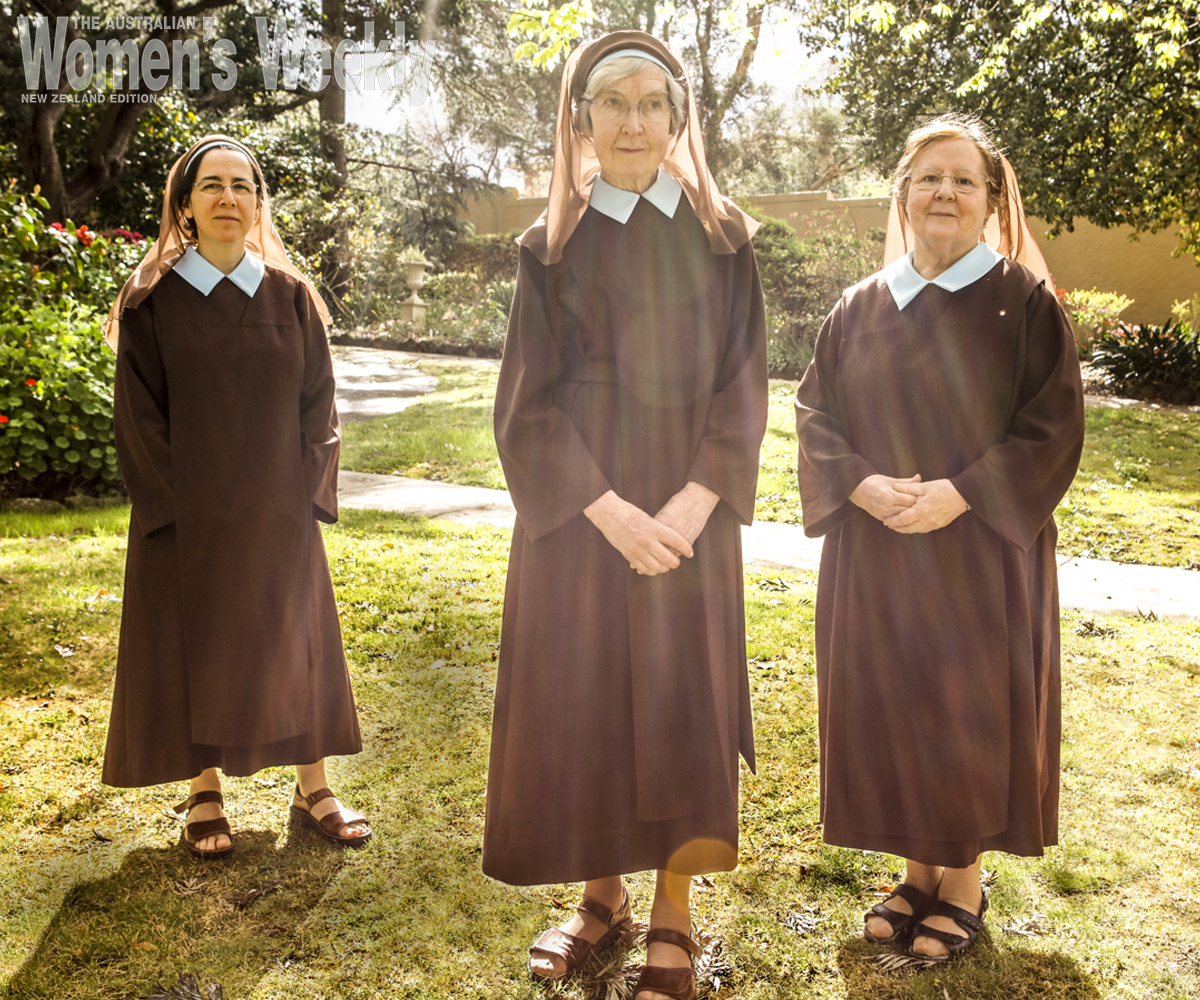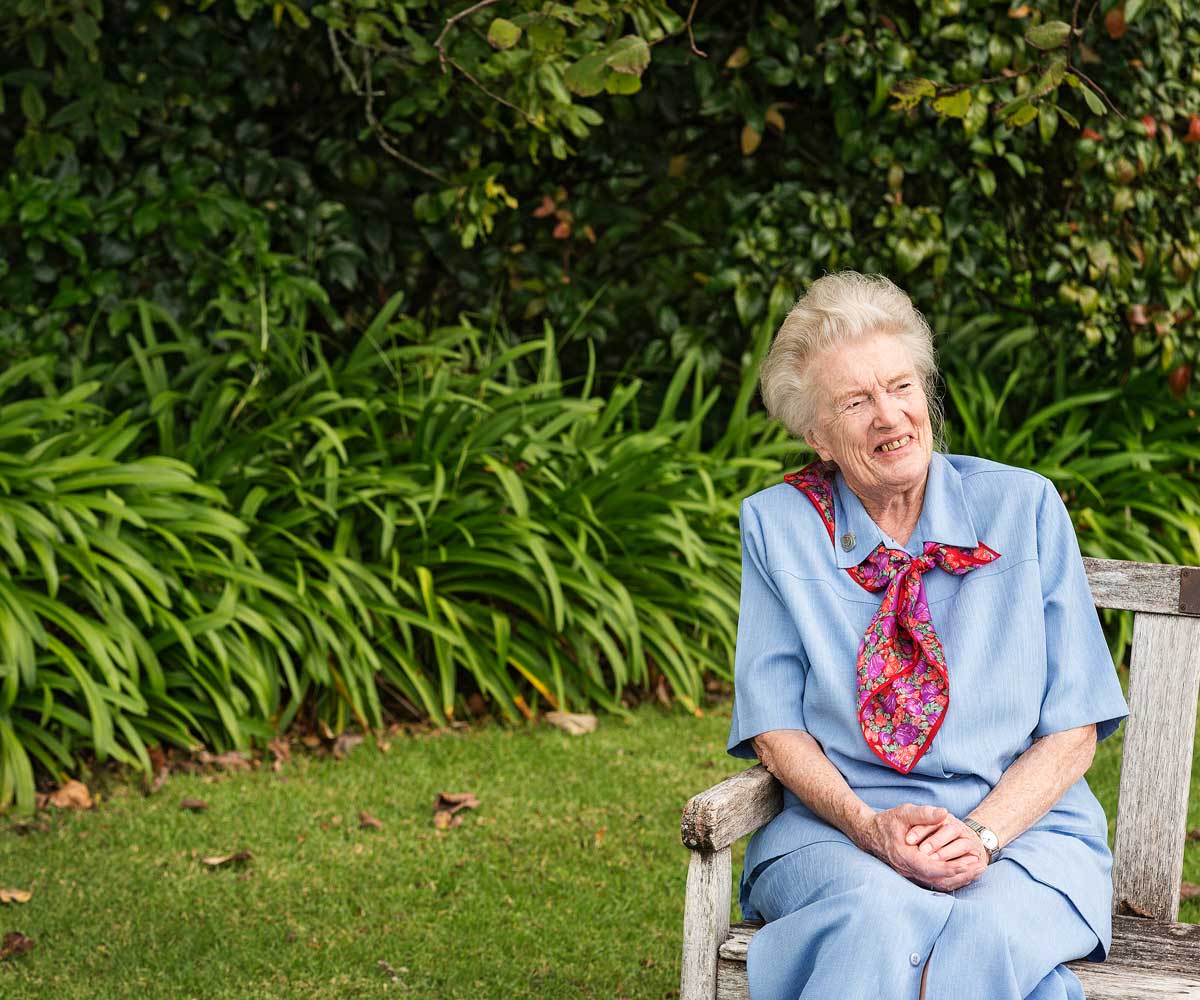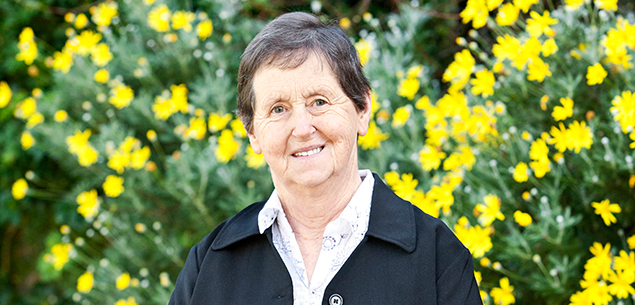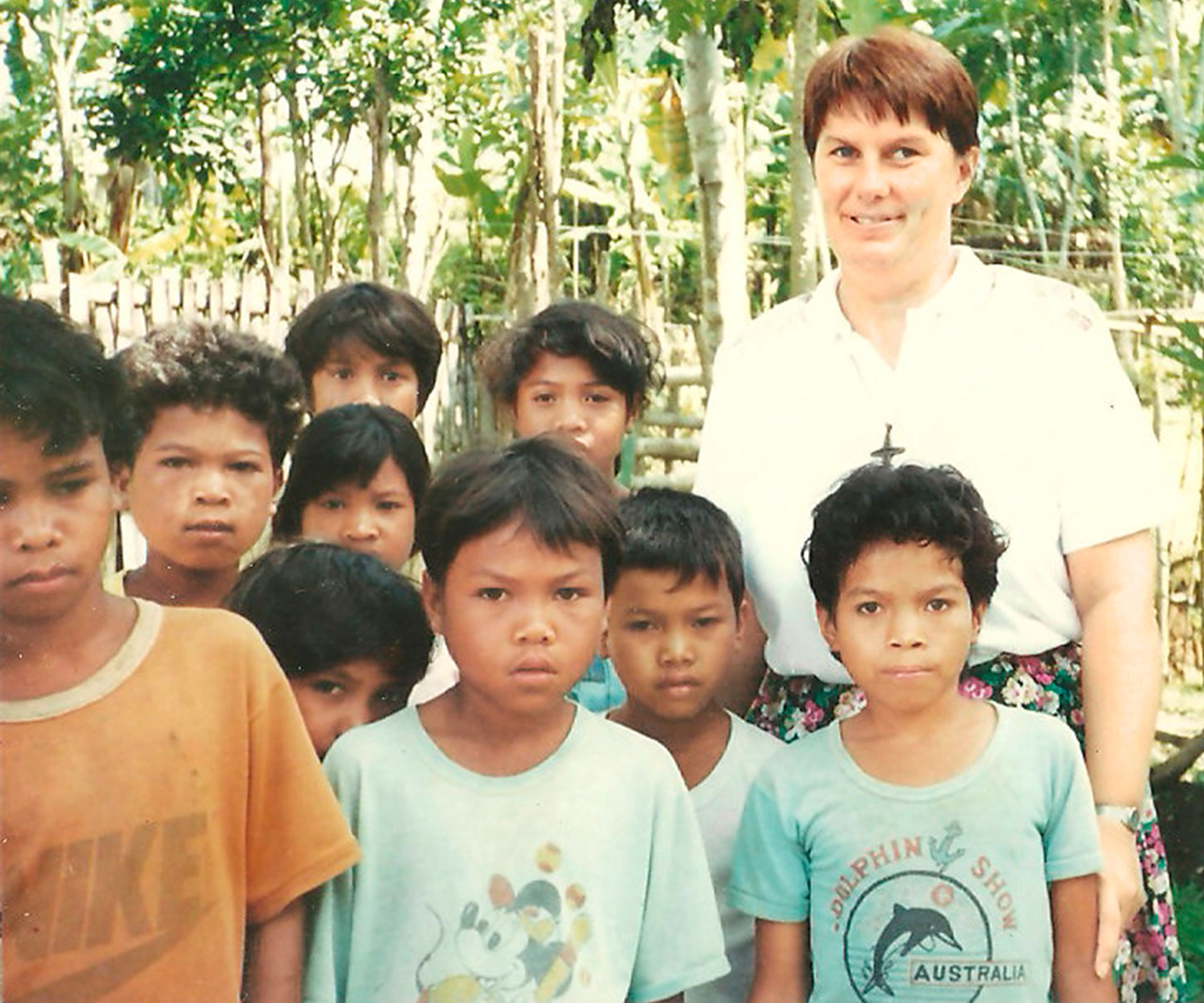Among the multimillion-dollar mansions and architect-designed homes that enjoy unparalleled views of the city skyline, one sprawling property stands out on Melbourne’s Kew Street.
Like Willy Wonka’s mysterious chocolate factory, just the rooftops and an intriguing bell tower can be seen over an imposing caramel-coloured stucco wall that forms the perimeter of the vast blue-chip estate.
The stately barrier doesn’t hide the home of a mystery billionaire, and rather than signalling that strangers are not welcome here, the property’s enormous wrought-iron gates are enthusiastically opened at dawn, for anyone seeking respite from the morning madness.
This is a Carmelite monastery, a little slice of heaven amid Melbourne’s angry urban sprawl, and The Australian Women’s Weekly has been invited to take a rare look inside.
The handful of nuns who live here still dress in an austere brown habit and veil, and obey ancient vows of chastity, poverty and prayer, but these women and their mission are anything but antiquated.
Today, God’s work is done in 3G. The modern nuns spend their days trying to soothe society’s fractious souls online, answering prayer requests from every corner of the world, while transforming their vast property into a sustainable oasis and running their popular skincare business.
Yes, you read that right. The enterprising Carmelites have their own lab tucked away in the convent’s vast gardens, from where they manufacture, package and sell their Monastique range of beauty products to customers all over the world, and they can hardly keep up with demand.

The historical property, which opened in 1929, is now one of Melbourne’s most valuable expanses of land.
“Elizabeth Arden started in the kitchen too,” quips Sister Rosemary with a cheeky grin.
“We are just like any other family who needs to earn a living,” explains Sister Paula.
“Back in the 1960s we needed to find a steady income and we were fortunate that one of the sisters had practised pharmacy before she came to the Order and she knew what to do. It’s been going ever since.”
There’s an obvious serenity that greets you when you walk through the mother-of-pearly gates of the Carmelite monastery.
Behind the wall there’s an instant sense of calm and tranquility, largely due to the lush gardens that stretch around the 3.5ha property, providing a green buffer that soaks up the noise and bustle outside.
It would be easy to assume that in this fast-paced, 24/7 Snapchat society the Carmelite nuns are losing relevance, but to the contrary, on any given day this place provides a haven for dozens of people seeking serenity.
The nuns host school groups, corporate retreats, community groups, artisans and have many bookings for parishioner weddings. Funerals are common, too.
Far from being removed from society, the nuns are acutely tuned to the world and its problems and Sister Paula says that requests for prayers and help are at record numbers.
Soothing society’s troubles is these women’s work, and business is booming.
“More than ever people have a need for quiet in their lives,” she says.
“Rushing around and going to work to make more money is not what life is all about. We find that many people are searching for something more than materialism, something meaningful in their lives. I think people have become totally dependent on things, and things don’t make you happy. Simplicity is freeing.”
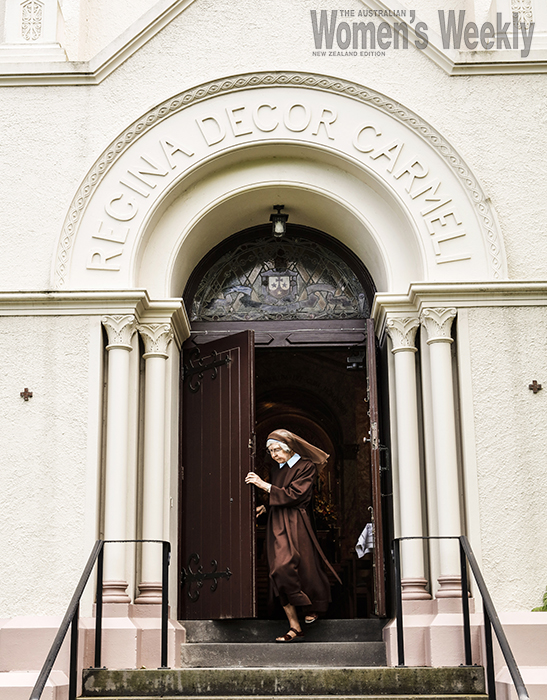
The gates are opened each day at dawn for parishioners or those seeking solitude from
the city.
The Carmelites officially began their work here in 1929.
They arrived seven years earlier and began transforming horse paddocks on the banks of the Yarra River into the oasis the monastery is today. An ornate chapel is the centrepiece of the historical property, which is one of Melbourne’s most valuable expanses of land, a jewel in every property developer’s eye, but for the record, “it’s not for sale”, Sister Paula says firmly.
Sisters Paula, Marie, Isabella and Rosemary take us on a guided tour of the grounds. As we weave through manicured lawns and beds of brilliant blooms, a sense of delight in one another’s company and an obvious camaraderie are clear. The women often finish one another’s sentences.
“We are a family,” Sister Paula smiles as she explains how, decades ago, one young nun with a green thumb made it her life’s work to create the stunning garden.
“She diligently put in garden beds, cuttings and bulbs. This was her apostolate [her spiritual work] and she wanted to give something special. Today the garden is a wonderful place of beauty and colour.”
In recent years, the garden has benefited from gifts of cuttings and trees from visiting nuns, local nurseries and parishioners, such as the elderly man who left the sisters his entire orchid collection, dozens and dozens of cascading orchids which now form the centrepiece of the monastery’s “Vatican Garden”.
“Every plant has a purpose, a history and an intent – nothing is random in the garden,” says Sister Marie, who was 27 when she gave up a nursing career to join the Order.
“I loved nursing but in my heart, this was my vocation – it was just something I instinctively knew.”

Inside the orante chapel.
Tucked away behind rows and rows of vegetables, soon to be harvested, and fruit trees as far as the eye can see is a bee-garden, where the nuns have their own hives with specially curated plant varieties to support a thriving bee colony.
Sister Isabella is the convent’s beekeeper. The petite nun came to the Order in 1989 after graduating from a music degree at Victoria’s prestigious College of the Arts.
She’d visited the convent during special celebrations and felt drawn to the very musical life the Carmelites lead.
“The bees are so interesting,” she says. “They seem to love lavender. It makes the most delicious honey, so we’ve planted lots of lavender around the hives for them.”
Twice a year the convent’s honey is harvested and bottled, and a lucky few regular parishioners snap up the pure blend.
Each nun takes care of a particular section of the garden and as we make our way past rows of lush azalea bushes, Sister Rosemary, who came to the convent after a career nursing neo-natal babies, jokes: “My garden is a bit of a wilderness at the moment, so we’ll just bypass that!”

Twice a year the convent harvests their own honey for parishioners to enjoy.
Inside, the convent is austere.
Well-worn floral carpet covers the floors and rich timber panelling the walls, but there is a warmth here that can never be measured in curtains and carpet. Those in need find comfort here.
These women, who own nothing, give their all, greeting their guests with a cup of tea and an unwavering ear. Judgement is never on offer.
In years gone by, a huge box of mail would be waiting for the sisters at the local post office each morning – requests for special prayers for sick loved ones or those in need.
Today those requests come via email, thick and fast, day and night. It’s not uncommon for the nuns to still be taking calls at 9pm.
“We answer every request,” Sister Paula says. “We don’t take any request for help for granted. Peace is there for all of us to find. People can be lonely – sometimes just a smile, a hello or a cup of tea can do the world of good. We keep our gates open as a sign of welcome and all are welcome here.”

Much of the sisters’ life still revolves around ancient rituals and prayer.
Equally, the internet has helped them promote and sell their skincare range to all corners of the globe.
The Monastique business began in the 1960s, after Vatican II, when the Pope declared that the Catholic Church needed to adapt to modern times and support itself.
A guest to the convent brought the nuns a bottle of rare perfume made by Cistercian monks in remote Caldey Island, Wales, and the then Mother Superior sniffed an opportunity.
“Inspired by their idea, Mother got in touch with the monks to see if we could do a similar thing. One of our nuns had been a pharmacist, so she got working right away creating our own formula, which has been in use ever since,” Sister Paula explains.
They began with a rose hand lotion (which is still one of their best-sellers), then perfume, and the range now extends to shampoo, talc, skin creams, cosmetics and even a popular “Cardinal” men’s line, all made with their trademark “peace, prayer and unhurried care”.
Sales of the Monastique range help support the 20 nuns residing here and fund the upkeep of the property, such as the recent addition of solar panels on the roof and water tanks to sustain the garden.
“Many of the people who purchase it will come here to visit us, but nowadays we also sell online and take phone orders,” says Sister Rosemary.
When I ask if I can take a sneak peek inside the laboratory, she reluctantly agrees, on the condition there are no photographs inside the lab.
“Our formula is top secret,” she says with a grin. “We are not a factory and we are not in competition with Estée Lauder, but it’s very feminine work and very enjoyable, and a bit more exciting than just making pickles or jam or something like that.”

The garden at the monastery is the pride and joy of the Order, where manicured garden beds burst with colour.
Despite the very modern demands of convent life today, much of the sisters’ life still revolves around ancient rituals.
They start the day at dawn with prayer and chapel, often tending to parishioners popping into mass on their way to work.
Then the nuns get down to business, before breaking for lunch and midday prayers. Then it’s back to work for the afternoon before dinner and evening prayers.
“There’s a warning bell to tell us it’s time to get to Chapel and often [the convent dogs] Papillon’s Ella and Tippy are the first ones there,” Sister Paula smiles.
After evening prayers the nuns return to work, to ensure that those who’ve emailed requests wake to prayers, thoughts and good wishes from the Carmelites of Kew.
“We have modernised and it’s wonderful that we can give people comfort and responses very quickly but,” Sister Paula cautions, “it can’t be the essence of your life. I can switch off and I do switch off often. I don’t let the computer dominate my day. The modern devices we have are about enriching our lives and enabling us to enrich others, not distracting us from what’s important. At the heart of our life is prayerfulness. We set aside times right through the day to stop and contemplate. There are days when we are very busy and pushed, often beyond what we’d like, but we always take a moment to stop and reflect and that brings with it a serenity.”
“This place is a powerhouse of prayer,” adds Sister Marie.
“You can feel it as soon as you enter and we can sense when someone needs prayer. More often than not we can see the tension release in someone as soon as they ask for prayer – it’s a release of stress they’ve been carrying. When they know the sisters will pray for them, they’re lighter straightaway. Prayer might not change their situation, but it gives them the grace to handle life’s challenges.”

As we finish our tour, Sister Paula, who knocked back a university scholarship to join the Carmelites at the tender age of 17, offers tea and shortbread while we chat about the future of the Order.
Most of the women here are beyond their 50s and renewal is challenging.
The convent may not be an appealing career choice for Gen X women and their numbers are dwindling, but curiously those showing the most interest are women aged 40+, who have had careers and experienced the world and are now looking for something else in their lives.
The nuns will welcome two novices before the end of this year.
“The next wave of women coming to us are slightly older and more mature,” says Sister Paula. “They’ve lived other lives and are now committed to looking at life at a deeper level. We will carry on through them, and as the world changes, so too will the women who are looking for a contemplative life… I see so much good in young people of the future, so much good around us, and I feel a great sense of positivity that we can continue making a contribution to the world.”
